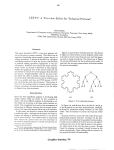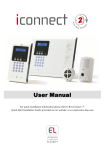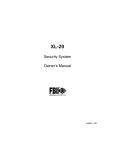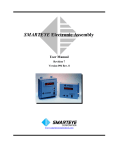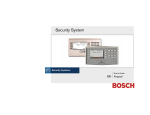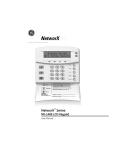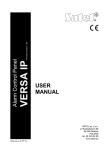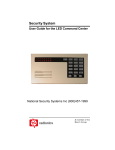Download D720 LED Command Center User`s Guide
Transcript
LED Command Center U s e r ’ s G u i d e Fire Safety Residential fire is a leading cause of accidental death. Most fire related deaths occur at night when the occupants suffocate in their sleep from smoke and deadly gases, rather than from burns. To help reduce this risk, the following three-step program should be implemented:’ 1. Minimize fire hazards around the home. Smoking in bed, cleaning with flammable liquids such as gasoline, leaving children home alone, and unsafe Holiday decorations are some of the more common causes of household fire. 2. Install a fire warning system. The primary purpose of this system is to protect lives, not property, by giving the earliest possible warning of the danger. In the event of a fire, the alarm system generates a loud intermittent tone distinctly different than a burglar alarm. Possible escape routes through open windows marked with arrows. Primary and alternate escape routes should be established. Since stairwells and hallways may be blocked during a fire, exiting through a bedroom window at night should be an essential part of the escape plan. If the sleeping area is above the ground floor, provide a means for safely descending outside the building if one does not already exist. As part of this plan, all family members should arrange to meet at a predetermined location away from the house (such as a neighbors), to verify that all are accounted for. In homes with more than one sleeping area a smoke detector (indicated by an inverted “s” in a circle) should be provided to protect each area. 3. Plan and practice an escape plan. A fire alarm warning may be wasted unless the family has planned for a quick evacuation. Because there may be very little time between detection of a fire and the time it becomes deadly, it is important that every member of the family understand exactly what to do. In Case of Fire 1. The primary purpose of a fire warning system is to protect lives. In the event of a fire alarm, quickly leave the building and call the fire department from a neighbor’s or public telephone. 2. If it is determined the alarm was accidentally tripped, the bell should be silenced, the detectors reset and your alarm company notified immediately of the situation. 1 Introduction Your security system helps to secure life, property, and investments against fire, theft, and bodily harm. The Command Center is an arming station that offers a variety of features. Function, versatility, and ease of operation make the Command Center the ideal system for the home or office. With custom programming, the Command Center is tailored to meet your individual needs. The Command mode allows you to perform a variety of functions with maximum simplicity - only the touch of two or three keys is required to control almost every feature on the Command Center. Three function keys allow common commands to be performed with the touch of just one key. The Command Center - putting the control of your security system right at your fingertips. Maintenance and Service The Command Center requires very little maintenance, however, the system should be tested weekly to insure early detection of a need for service. A test schedule and maintenance program can be arranged with your alarm company. If a change in operation is noticed during normal use or testing, call for service as soon as possible. Do not attempt to repair the control panel, arming stations, or detectors yourself. Call _________________________________________ Before Testing The security system is connected to this telephone number: __________________________________________________________ The security control panel is connected to the phone jack located: AC Power Failure If your command center indicates that AC power has failed, and you have power in the remainder of your premises, there may be a problem with the electrical transformer or circuit breaker supplying power to your security control panel. First, check to be sure that the transformer is securely plugged into the electrical outlet. If it appears to be damaged in any way, do not attempt to repair it. Call your security company for service. Transformer location: _________________________________________ If the transformer is plugged in, check the circuit breaker supplying power to the outlet. If the breaker is tripped, reset it. If it trips again, the overload condition must be corrected. Circuit breaker location: _______________________________________ INDEX Fire Safety 1 Security System Basics 3 The Command Center Keypad 5 Turning the System On and Off 6 Silencing and Reporting Alarms 7 Command Center Alerting Tones 8 System Commands 9 Security System Glossary 28 Security System Limitations 29 __________________________________________________________ 2 The Command Center The Command Center is an illuminated digital arming station that is the command center for your entire security system. The Command Center does much more than just arm and disarm your security system; it can initiate several system commands. A system status display panel keeps you informed of security conditions, as well as storing alarm information for future reference. It also indicates various security system conditions such as your system’s armed status, protective point status, power supply status, and Command mode status. A built-in sounder alerts you of several different conditions which may require action. The Command Center also includes three function keys which can perform many system commands with the touch of one key. Security System Basics What is a Point? A “point” is a detection device, or group of devices connected to your security system. Each area of your property is assigned to a specific point with a number. A point can be a single door (like the entrance door) or an area of your property (like the second floor). Each point is represented by its point number on the Command Center display panel. There are two basic types of points, controlled and 24-hour. Controlled Points Controlled points respond to alarm conditions depending upon whether the system is turned on (armed) or turned off (disarmed). Controlled points are programmed to respond instantly to alarm conditions or to provide a delay for you to reach the command center and disarm the system. There are two types of controlled points, perimeter and interior. 1. Perimeter Points: All exterior doors and windows of the building, forming the outside “wall of protection” around your building. 2. Interior Points: All interior forms of burglary protection (carpet mats, motion sensors, inside doors, etc.). 24-Hour Points 24-hour points are always on, even when the burglary system is disarmed (turned off). There are two types of 24-hour points, fire points and non-fire points. 1. Fire Points: Fire points exclusively monitor fire detection devices. They are always armed and cannot be disarmed. Fire alarms have a unique audible warning signal. 2. Non-Fire Points: Non-fire points are always armed and cannot be disarmed. 3 Command Center Features Armed Status Indicators Three lights are used to indicate the armed status of your security system. Each of these lights is explained below. During an exit delay period these lights flash on and off slowly. Perimeter-- When this red indicator is lit, your perimeter points are armed. When this indicator is not lit, your system is not armed. Interior -- When this yellow indicator is lit, your interior points are armed. When this indicator is not lit, your interior points are not armed. Instant-- This red indicator shows how your system is armed: either instant or delayed. When this indicator is lit, your security system is armed without entry/exit delay time. When the system is armed with entry/ exit delay, this indicator is not lit. Point Status Indicators Point status indicators on the Command Center show the condition of your system’s protective points. Each point has its own indicator which can show three different point conditions (listed in order of priority). Point Bypass -- When a point is bypassed (not armed with the rest of the system), its indicator light flashes on and off slowly. Faulted Point -- A faulted point is indicated by a steadily lighted point status indicator. Point Alarm Memory -- When a point has been faulted into alarm its indicator flashes on and off rapidly. The Point Status Indicators also indicate whether the system is ready to arm or not. If the point status indicators are not lit, the system can be armed by entering your personal passcode or any of the arming commands available to your system. If any of the point status indicators are lit, the system has a faulted point. Correcting the faulted point will usually mean closing a door or window. Power Indicator When the red PWR indicator LED lights steadily, your security system is operating from AC voltage and the standby battery is fully charged. When the PWR indicator is off, AC or battery power are not present. When flashing slowly, a low battery power condition is indicated. When flashing quickly, battery power is missing. It the indicator is either off or continues to flash, contact your security company. Command Mode Indicator When the COMMAND bar is pressed, the red Command Mode indicator (CMD) lights steadily to show that the system is ready to accept a command. If the command requires that a passcode be entered, the CMD indicator will slowly blink, prompting you to enter your passcode. Once a passcode is entered, the Command Mode indicator lights steadily again and remains steadily lit while the system is in the command mode. The indicator goes off when the command is completed (or after 15 seconds of inactivity). Note: It all of the command center’s LEDs are blinking in unison, the system requires service. Exiting the Command Mode Sometimes you may decide to exit the command mode before completing the chosen function. You can exit the command mode at any time by pressing the A key. The CMD light will go off, confirming that you’ve left the command mode. 4 The Command Center Keypad The Command Center has a lighted digital keypad used to enter passcodes and system commands into the security system. As you touch the keys to enter a passcode, the Command Center emits a short beep tone to indicate that your entry is accepted. COMMAND Bar The COMMAND bar is used to perform one- or two-digit COMMAND functions. Note: Some systems require a security passcode to be entered after the function keys or COMMAND bar have been pressed. If a passcode is required, the CMD light will blink. You should enter your passcode when you see this light blinking. Enter (ENT) Key When the passcode has been completed, you must press the ENT (ENTER) key to activate the passcode. If you do not press the ENT key, the passcode is ignored by the security System. When entering a passcode or command at the Command Center, each key must be pressed within five seconds of the last key entry. After five seconds have expired from the last key entry, the entire entry is cleared and the passcode must be started over. Function Keys The Command Center has three function keys (labeled A, B, and C). The function keys can be used to perform system commands with the touch of one key. Your alarm technician programs the Function Keys. Function Key A Function Performed ______________________________ ______________________________ B ______________________________ ______________________________ C ______________________________ ______________________________ Note: The A, B, and C keys can perform various functions. These functions may require a few seconds before they are completed, because the system is completing several instructions at once. Therefore, please wait for 5 seconds after using the A, B, or C keys to allow the system to “catch up.” 5 Turning the System On (Arming) Your security system can be turned on (armed) in many different ways, depending on the arming command used. Arming commands are those commands used to turn the system on. The most basic arming command is to arm the entire system. The simplest way to arm your system is to enter your personal passcode and press ENT or to use COMMAND 1. There are several other arming commands to turn the system on. For example: arm only the perimeter, arm only portions of the perimeter, etc. These arming functions and their respective commands are described later in this guide. Turning the System Off (Disarming) Your security system is turned off by entering your personal passcode and pressing ENT. When your system is turned on, you must enter the premises through a designated entry door to prevent an immediate instant alarm condition. Opening the door starts an entry delay time and the Command Center emits a pulsing “beep” tone to remind you to turn the system off. Enter your personal passcode and press ENT before the delay time expires and the system will turn off. If you enter through a wrong door or fail to disarm before the entry delay expires, you will cause an alarm. If this happens, silence the alarm (by entering your personal passcode and pressing ENT) and call your security company to let them know that it is not an emergency situation. 6 Silencing an Alarm The audible alarm sounds for a specific period of time before it automatically shuts off. If an alarm occurs and you want to silence the bell or siren before the time expires, simply enter your personal passcode and press ENT. After silencing the alarm and returning points to normal, you can clear the alarm memory lights by entering your passcode twice (arm and disarm). On some systems the alarm memory lights can be cleared by entering COMMAND 4. Reporting to the Central Station ❒ My system reports to a Central Station. ❒ My system does not report to a Central Station. Your system may be programmed to send a “closing” report to your security company when arming. ❒ ❒ My system sends a closing report. My system does not send a closing report. • Enter your personal passcode and press ENT. Your system may be programmed to send an “opening” report to your security company when disarming. Note: Some security systems are programmed so that bells or sirens cannot be silenced until the point is restored to a normal (non-alarm) condition. ❒ ❒ To SILENCE an alarm: My system sends an opening report. My system does not send an opening report. Your system may be programmed to report Force Arming to your security company. ❒ ❒ Force Arming will be reported to my security company. Force Arming will not be reported to my security company. Your security system automatically disconnects your telephone from its line when transmitting reports to your security company. This prevents reports from being interrupted during transmission. Once the report has been completed, the telephone line is restored to normal service. Note: If damage occurs to the telephone line and your telephone service is interrupted, reports will not be transmitted to your security company unless an alternate means of transmitting signals is installed in your system. 7 Command Center Tones Your command center emits one of several distinct tones to alert you to system events. Additional bells or sirens may also be connected to your system. Bells or sirens mounted on the exterior of your premises alert neighbors to emergencies and provide an audible guide for police and fire fighters. Some of these tones are optional, and can be selected by your alarm technician. Exit Delay Tone: After you arm your system, the command center emits a repeating beep tone and counts down the exit delay time. If you don’t exit before the delay time expires, and an exit delay door is faulted, entry delay will begin. 5. Keystroke Checking Tones: Pressing any key on the Command Center sounds a short beep tone. When you press an incorrect key, a flat buzz tone sounds to indicate an invalid entry. 1. Fire Alarms: Fire alarms are the highest priority events. When a fire point activates, your command center emits a fast, pulsating, high-pitched tone. Evacuate all occupants and investigate for smoke or tire. Ensure that all occupants know the difference between the burglary tone and the tire tone. The tone sounds for the time set by your security company. The command center point status LEDs will show the tire points in alarm. Note: Some points, such as tire points, may be programmed so that the sounder cannot be silenced until the point fault is corrected. 6. Faulted Point: When you enter an arming command, and a point is faulted, the sounder is activated for two seconds. The point status indicator associated with the faulted point is lighted. 2. Burglary Alarms: Burglary alarms are the second priority. When a burglary point activates while your system is armed, your command center emits a pulsating burglary tone. The tone sounds for the time set by your security company. The command center point status LEDs will show the burglary points in alarm. Some system trouble events can produce a trouble tone without producing any status light indications. These trouble events fall into three categories: 3. System Trouble Events: When a system component is not functioning properly, your command center may be programmed to emit three warble tones, then a pause (repeatedly). If the problem is with a point, then the point status light indicates which point is faulted. To silence the system trouble tone, enter COMMAND 4 or your personal passcode followed by ENT. 4. Entry Delay Tone: When you enter the premises through a point programmed for entry delay, the command center emits a repeating tweedle tone to remind you to turn off your system. 7. Watch Tone: When the Watch Mode is activated, the Command Center emits a brief tone to alert you when any watch point is faulted and the point indicator lights to indicate which point is faulted. The tone sounds only when the door or window is opened. It does not sound again for that point until the door or window is closed and then reopened. 1. Hardware, Software, or Wiring problems. This could mean, for example, that a keypad had been unplugged from the command center or that the printer has been unplugged. Call your security company. 2. Communication or Phone Failure. This could mean, for example, that you have phone line trouble. Call your security company. 3. Late to Close Reminder Tone. If your system is programmed to send a closing report, your command center will sound the trouble tone to remind you that it is time to close. Arm your system to silence the tone. 8 Turn the Entire System On With Delays ❒ I have this feature. ❒ I do not have this feature. ❒ This feature requires a passcode. COMMAND 1 is used to arm the entire system, both perimeter and interior points. Once you have entered COMMAND 1, the exit delay time starts. You now have a predetermined amount of time to exit the protected area before the system arms. During the exit period, you can move through motion detectors or any protected area on your way to any exit without causing an alarm. To cancel COMMAND 1, enter your personal passcode and press ENT. Note: If you leave the building after the exit time expires, you may begin the entry delay, or initiate an alarm. It this happens, disarm your system by entering your personal passcode and press ENT. It your system reports to a Central Station, you need to call them if an alarm occurs. COMMAND 1 Arming with COMMAND 1: 1. Ensure that all points are secure. All of the Point Status indicator lights on the Command Center should be off. If they’re not, see the section describing Force Arming the System. 2. Press the COMMAND bar. The Command Mode indicator light comes on. 3. Press the 1 key. The PERIMETER indicator and the INTERIOR indicator lights begin to flash on and off. This indicates that the system has begun exit delay time. 4. To disarm your security system or cancel COMMAND 1, enter your personal passcode and press ENT before the delay time expires. Application COMMAND 1 is useful in applications where you want your cleaning service, a service person, or anyone else to arm your system when they leave, but you do not want them to have the passcode to disarm the system. COMMAND 1 arms the system, but it will not disarm the system. 9 Turn the Entire System On Without Delays ❒ I have this feature. ❒ I do not have this feature. ❒ This feature requires a passcode. Use this function to turn on the entire system, both perimeter and interior without delays. When entering COMMAND 11, remember that the second 1 must be pressed within 2 seconds after pressing the first 1 . COMMAND 1 1 Using Command 11: 1. Ensure that all points are secure. All of the Point Status indicator lights on the Command Center should be off. If they’re not, see the section describing Force Arming the System. 2. Press the COMMAND bar. The Command Mode indicator light comes on. 3. Press the 1 key. Now press the 1 key again. 4. The PERIMETER, INSTANT, and INTERIOR lights come on. This indicates that the perimeter, instant, and interior points are armed without entry/exit delay time. 5. To disarm your security system, enter your personal passcode and press ENT. 10 Turn On the Perimeter With No Delays ❒ I have this feature. ❒ I do not have this feature. ❒ This feature requires a passcode. COMMAND 2 is used to arm only the perimeter of your building, leaving the interior of the building disarmed. This command allows no exit or entry delay time through the perimeter, including the designated delay door. Enter your personal passcode, plus ENT, to cancel COMMAND 2. Remember there are no entry or exit delays when you use this function. You must disarm (turn off) the system to enter or exit the premises. Application This arming command is useful in residential systems at night when everyone is home and ready to retire for the evening. COMMAND 2 Arming with COMMAND 2: 1. Ensure that all perimeter points are secure. Interior points are not armed with this command, and may remain faulted while arming with COMMAND 2. Perimeter point status lights should be off. If they’re not, see the section describing Force Arming the System. 2. Press the COMMAND bar. The Command Mode indicator light comes on 3. Press the 2 key. The PERIMETER and INSTANT indicator lights come on. This indicates that the perimeter points are armed without entry/exit delay time. 4. To disarm your security system or cancel COMMAND 2, enter your personal passcode and press ENT before the delay time expires. In commercial installations, this arming command is useful when you are working late and you want the perimeter of the building armed until you are ready to leave. 11 Turn On the Perimeter With Delays ❒ I have this feature. ❒ I do not have this feature. ❒ This feature requires a passcode. COMMAND 3 is used to arm only the perimeter of your building, leaving the interior of the building disarmed. Once you have entered COMMAND 3, the exit delay time starts. You now have a predetermined amount of time to leave before the perimeter arms. Enter your personal passcode and press ENT, to cancel COMMAND 3. Application This arming command is useful in residential systems when you are leaving, but members of your family, a baby-sitter, or a pet, are still inside the house. COMMAND 3 Arming with COMMAND 3: 1. Ensure that all perimeter points are secure. Interior points are not armed with this command and may remain faulted while arming with COMMAND 3. Perimeter point status lights should be off. If they’re not, see the section describing Force Arming the System. 2. Press the COMMAND bar. The Command Mode indicator light comes on. 3. Press the 3 key. The PERIMETER indicator light flashes. This indicates that the system has begun exit delay time. When the delay time expires, the light remains steady. 4. To disarm your security system or cancel COMMAND 3, enter your personal passcode and press ENT before the delay time expires. In commercial installations, use this command to rearm your system when you are on the premises, but not yet open for business. 12 Silence the Trouble Sounder ❒ I have this feature. ❒ I do not have this feature. ❒ This feature requires a passcode. Use COMMAND 4 to silence the trouble sounder during system trouble events. COMMAND 4 To use COMMAND 4: 1. Press the COMMAND bar. The Command Mode indicator light comes on. 2. Press the 4 key. The Command Center trouble sounder is silenced, and any flashing Point Status indicator lights are turned off if the point is normal. If the point is not normal, its indicator light will stay on solidly, indicating the need for attention. 13 Send Report ❒ I have this feature as Command 41. COMMAND 4 1 & 4 2 To use COMMAND 4 1 or COMMAND 4 2: ❒ I have this feature as Command 42. 1. Always call your security company before sending a test report. ❒ I do not have this feature. 2. Ensure that your security system is disarmed. ❒ This feature requires a passcode. 3. Press the COMMAND bar. The Command Mode indicator light comes on. This function tests the communication link between your security system and your security company. It is an important part of maintaining a high level of security for your property. Two types of test reports may be sent. The first type (Command 41) simply tests the communication of security messages to your security company. The second type is a status report (Command 42). This status report sends the current condition of your system in addition to testing the communication link to your security company. 4. Press the 4 key, and then press the 1 key, or press the 4 key and then the 2 key for COMMAND 42. 5. After the report is received at your security company, the Command Center will emit a beep tone for two seconds. This is to confirm that the test signal was properly transmitted and received. 14 Enable Remote Account Management ❒ I have this feature. COMMAND 4 3 To use COMMAND 4 3: ❒ I do not have this feature. 1. Your system may be either armed or disarmed to perform this function. ❒ This feature requires a passcode. 2. Call your security company using this phone number: Your security system has the ability to be managed remotely from your security company without having a service person on the protected premises. By using COMMAND 4 3, you can enable remote account management. Remote account management is done with the aid of a specially equipped computer at your security company. Typical remote programming changes may include: adding or deleting system commands, and changing personal passcodes or entry/exit delay times. _________________________________________________________ This number is designated for the Remote Account Manager. You must make the call using the telephone located: _________________________________________________________ 3. Identify yourself and your premises (account number, name, address, etc.) and advise the operator of the programming changes you wish to have performed. 4. When the operator directs you, enter COMMAND 4 3 at your Command Center: Press the COMMAND bar. The Command Mode indicator light comes on. 5. Press the 4 key, and then press the 3 key. The telephone line that the call was made from is not active when remote account management is in progress. You may hang up the telephone. 6. When remote account management has been completed, your telephone line will automatically restore normal service. 15 Walk Test ❒ I have this feature. COMMAND 4 4 To use Walk Test: ❒ I do not have this feature. 1. Ensure that your security system is idle. ❒ This feature requires a passcode. 2. Press the COMMAND bar. The Command Mode indicator light comes on. Use this function to test command centers, detection devices, and sounders (both interior and exterior) to be certain they function properly. You can review untested points at your command center to help pin-point any problems. You cannot arm your system while in the walk test mode, and no alarm reports are sent to your security company unless a 24-hour point is activated (such as fire or panic). The AC will be disabled for 4 minutes in order to test the system’s battery power. If the battery cannot maintain the system for the 4 minute period, the command center will appear to go dead. If this happens, contact your security company. At the end of the 4 minute period, AC is returned to the system and the panel restores. 3. Press the 4 key, and then the 4 key again. Audible devices (both interior and exterior) sound the burglary bell. 4. After silencing the audible devices, you may test detection devices. Open a door or window, or activate a motion sensor. Each time a detection device has been tested, the Command Center will beep for 2 seconds. The Command Center display panel indicates the point which you have faulted. This verifies that the detection device is working properly. 5. To end the Walk Test, press any numeric key on the Command Center. If no activity occurs on the system for 20 minutes, the Walk Test will end automatically. To test individual detection devices, simply activate sensors and open protected doors and windows one-at-a-time. As each detection device is faulted, the Command Center emits a brief tone and the display indicates that the point has been tested. This verifies that each detection device is working properly. 16 Reset Sensors ❒ I have this feature. COMMAND 4 7 To reset detectors: ❒ I do not have this feature. 1. Ensure that your security system is disarmed. ❒ This feature requires a passcode. 2. Press the COMMAND bar. The Command Mode indicator light comes on. COMMAND 4 7 resets faulted detection devices. Devices may include smoke detectors, shock sensors or a variety of other detection devices. Ask your alarm technician which points you can reset from the Command Center by entering COMMAND 4 7. 3. Press the 4 key, and then press the 7 key. The display flickers momentarily and the command center emits multiple pips during reset. If you enter this function and the detector or sensor resets momentarily, but then returns to a faulted condition, the conditions causing the activation may still be present or the detector may be faulty. Check to be certain that there is no smoke, fire, or other danger present. If you can’t reset the detector or sensor contact your security company. 17 Delete Passcodes ❒ I have this feature. COMMAND 5 3 To delete passcodes: ❒ I do not have this feature. 1. Ensure that your security system is idle. ❒ This feature requires a passcode. 2. Press the COMMAND bar. The Command Mode indicator light comes on. Use COMMAND 53 to delete a personal passcode from your system without assistance from your security company. You need to know the user number for the passcode you want to delete. The two-digit user numbers identify users in reports transmitted from your system. 3. Press the 5 key, and then press the 3 key. Your security system is now in the passcode delete mode. 4. Enter the two-digit user number for the passcode you wish to delete. Press ENT. The passcode is now deleted. 18 Personal Passcode Change ❒ I have this feature. COMMAND 5 5 To change your personal passcode: ❒ I do not have this feature. 1. Ensure that your security system is idle. ❒ This feature requires a passcode. 2. Press the COMMAND bar. The Command Mode indicator light comes on. Your security system provides you with the convenient feature of changing your personal passcode whenever you feel it necessary, without the services of your alarm technician. It is recommended that you write down both your old and new passcodes before you begin. 3. Press the 5 key and then the 5 key again. Your security system now in the passcode change mode. 4. Enter the passcode you wish to change. Press the ENT key. Before You Begin: 5. Enter the new passcode. Press the ENT key. • Care should be given when entering a passcode containing the same digits in consecutive positions within the new passcode (e.g.: “3” in 33467). When entering this type of passcode, it is easy to make mistakes. 6. Enter the new passcode again. Press the ENT key. 7. Test the new passcode by using it to arm and disarm the system. Do not use any of the Command Center arming commands to arm the system until you are certain that the new passcode is working. • The passcode can be from 3 to 6 digits in length. • To avoid conflicting with other passcodes and duress codes, your system does not let you change to passcodes that are within plus or minus 2 of an existing passcode. For example, if 1234 were an existing code, your system would not let you change your code to 1232, 1233,1235, or 1236. 19 Fire Test ❒ I have this feature. COMMAND 5 8 To use Fire Test: ❒ I do not have this feature. 1. Ensure that your security system is idle. ❒ This feature requires a passcode. 2. Press the COMMAND bar. The Command Mode indicator light comes on. Use this function to lest fire points and other 24-hour points to be certain they function properly. You can review untested points at your command center to help pin-point any problems. Upon initiation, the fire test will test the fire bell pattern on the bell output and ring the command center fire bell for 2 seconds. The AC will be disabled for 4 minutes in order to test the system’s battery power. If the battery cannot maintain the system for the 4 minute period, the command center will appear to go dead. If this happens, contact your security company. At the end of the 4 minute period, AC is returned to the system and the panel restores. A message will be sent to your security company upon initiation and completion of the fire test. During the fire test, no 24-hour alarms will be sent to your security company. 3. Press the 5 key, and then the 8 key. Audible devices (both interior and exterior) sound the fire bell. 4. One-at-a-lime, activate the detection devices to fault each point. The audible fire devices sound momentarily, and the command center display indicates the point you’ve faulted. This verifies that the detection device is working properly. 5. To end the fire test, press any numeric key on the Command Center. If no activity occurs on the system for 20 minutes, the fire test will end automatically. If there is no activity on the system for 20 minutes, the system will automatically exit from the fire test. 20 Watch Mode ❒ I have this feature. COMMAND 6 To use COMMAND 6: ❒ I do not have this feature. 1. Ensure that your security system is idle. ❒ This feature requires a passcode. 2. Press the COMMAND bar. The Command Mode indicator light comes on. With your system disarmed, you can use watch mode to monitor selected points. Each time a watch point is faulted (door or window is opened) the command center chimes once. Note: Contact your security company to find out which points are watch points and whether or not your system automatically turns the Watch Mode on whenever you disarm. 3. Press the 6 key. The system is now in Perimeter Watch Mode. 4. To exit the Perimeter Watch Mode, press the COMMAND bar, and then the 6 key. Application This command is useful in a residential system when you want to monitor entrances or exits in your home. In commercial installations, the Watch Mode can be used as a door chime to alert you when a customer or delivery person has entered your business. 21 Special Alert ❒ I have this feature. ❒ I do not have this feature. ❒ This feature requires a passcode. This command is a manually operated and initiated alarm command. COMMAND 7 can be programmed to respond to a choice of numerous situations that may need immediate attention. This command may also be used to send a silent alarm to your security company without sounding an alarm signal on the premises. Check with your security company for the options they offer. COMMAND 7 To engage COMMAND 7: 1. Press the COMMAND bar. The Command Mode indicator light comes on. 2. Press the 7 key. Your COMMAND 7 special alert has been programmed to: _____ notify your alarm company _____ ring a bell on your premises Description: __________________________________________________________ __________________________________________________________ __________________________________________________________ __________________________________________________________ 22 Partially Turn On the Perimeter ❒ I have this feature. COMMAND 8 To arm with COMMAND 8: ❒ I do not have this feature. 1. Ensure that the command center is disarmed. ❒ This feature requires a passcode. 2. Decide which points are to be left disarmed. Fault the points (doors and windows) by leaving them open. The point(s) must remain open until after the exit delay time expires. This function is used to turn on the perimeter of your building while selected portions of the perimeter remain turned off. Perimeter points that are not secure (faulted) when this function is entered are not included in the system. This function does not turn on the interior of your building. Entry/exit delays are provided with this arming command. Application Use this function in residential systems to turn on the front of your house while the interior and the rear perimeter doors are left turned off, giving you freedom of movement between the house and patio. In commercial systems, when you need access to the large overhead doors to receive deliveries, using this function will allow you to keep the rest of the building perimeter armed. 2. Press the COMMAND bar. The Command Mode indicator light comes on. 3. Press the 8 key. The PERIMETER indicator light begins to flash. This indicates that the system has begun exit delay time. When the exit delay has expired, the PERIMETER indicator is continuously lit. 4. When performing a COMMAND 8, and no points are faulted, or the points return to normal before the exit delay time expires, the system is armed as in COMMAND 3. 5. To disarm your security system or cancel COMMAND 8, enter your personal passcode then press ENT. 23 Special Alert ❒ I have this feature. ❒ I do not have this feature. ❒ This feature requires a passcode. This command is a manually operated and initiated alarm command. COMMAND 9 can be programmed to respond to a choice of numerous situations that may need immediate attention. This command may also be used to send a silent alarm to your security company without sounding an alarm signal on the premises. Check with your security company for the options they offer. COMMAND 9 To engage COMMAND 9: 1. Press the COMMAND bar. The Command Mode indicator light comes on. 2. Press the 9 key. Your COMMAND 9 special alert has been programmed to: _____ notify your alarm company _____ ring a bell on your premises Description: __________________________________________________________ __________________________________________________________ __________________________________________________________ __________________________________________________________ 24 Bypass a Point ❒ I have this feature. COMMAND 0 To use Bypass aPoint: ❒ I do not have this feature. 1. Ensure that your security system is disarmed. ❒ This feature requires a passcode. 2. Press the COMMAND bar. The Command Mode indicator light comes on. The Command Center makes it easy for you to have complete control of your security system. With COMMAND 0 you have the ability to bypass points you do not want included in the system. You can bypass points when an area is disarmed. Bypassing a point reduces the level of security and should be used with discretion. Points remain bypassed until you unbypass them (see Unbypassing a Point) or some points may return when the area is disarmed. 3. Press the 0 key. The system is now in the Bypass mode. (Some points may be set by your alarm company so that they cannot be bypassed). 4. To bypass a point, press the key that corresponds with the number of that point, and then the ENT key. The point status light corresponding to the bypassed point will flash, indicating that the point has been bypassed. 25 Unbypass a Point ❒ I have this feature. COMMAND 0 0 To Unbypass a Point: ❒ I do not have this feature. 1. Ensure that your security system is disarmed. ❒ This feature requires a passcode. 2. Press the COMMAND bar. The Command Mode indicator light comes on. Unbypassing a point is a way to return a bypassed point to the security system so that it can once again respond to trouble and alarm conditions. 3. Press the 0 key, then press the 0 key again. The system is now the Unbypass mode. 4. To unbypass a point, press the number key that corresponds to the number of the point that is flashing slowly, and then the ENT key. The point status light stops flashing, indicating that the point has been unbypassed. 26 Turning the System On With a Duress Passcode ❒ I have this feature. Passcode + 1, or + 2 ❒ I do not have this feature. The duress passcode is based on your personal passcode. By increasing the last digit by one or two, the duress feature is activated. Example: If your personal passcode is 1234, the duress passcode is 1235 (or 1236). ❒ This feature requires a passcode. ❒ My system uses Passcode + 1 for duress. ❒ My system uses Passcode + 2 for duress. A duress passcode is used to send a silent alarm signal to your security company. It arms or disarms the security system just like your personal passcode; however, as the system is armed or disarmed, an alarm signal is transmitted. Be sure that your security technician indicates how this feature works in your system. There is no alarm tone or visual indication at the premises that the report is sent. Application The duress passcode is used when someone threatens you and demands that you disarm (or arm) your security system. By disarming (or arming) with a duress passcode, your security company is alerted of an alarm situation. Note: If your system has a security passcode that “unlocks” the COMMAND bar, increasing the last digit of that passcode will send a duress signal to your security company. Important! Be sure to press the ENT key after entering the duress passcode. 27 Force Arming the System ❒ I have this feature. ❒ I do not have this feature. If a protected door or window is open, you may have the option of “force arming” with that point faulted. Faulted points (opened doors or windows) that are force armed are not included in the system. The remaining points arm normally. Your system might not offer force arming or it may be restricted to specific points. Contact your security company for more information. To arm with points faulted: 1. Enter your personal passcode and press the ENT key, or enter an arming command (COMMANDs 1, 2, or 3). The Command Center emits a “buzz” tone indicating a point is faulted. 2. Press the COMMAND bar and then the ENT key. The system now arms all points which are normal. Note: If the fault is restored (returned to normal) while arming, the point will be armed. If the fault is restored after arming, how your system is programmed determines whether or not the point will be armed with the rest of the system. ❒ A faulted point will be armed with the rest of the system if restored. ❒ A faulted point will not be armed with the rest of the system if restored and will not be armed until I disarm the security system and re-enter an arming command. I am allowed to have a maximum of ______ points faulted when force arming. 28 Security System Glossary Faulted Point - A point that is not normal (a door or window is open). Arm and Disarm - To switch your burglar detection devices “on” and “off.” When the burglar detection device is armed and is tripped, an alarm may be set off. When the burglar detection devices are disarmed, the security system will not detect intruders. Your security system is always “on” to provide 24-hour fire detection and police alert (optional). Force Arm - To turn on (arm) the security system even though one or more points are faulted. Force arming bypasses the faulted points. Bypass - The process of deliberately not including certain points of protection when arming the security system. Opening Report - A signal to your security company indicating that the system has just been disarmed. Commercial accounts may use these reports to indicate that the business is open. Central Station - A facility where trained personnel monitor your security system 24 hours a day. Your system may contact Central Station personnel to dispatch the proper authorities. Closing Report - A signal to your security company indicating that the system has been armed. Commercial accounts may use these reports to indicate that the business is now closed. Command Center - A command center displays system status, sounds warnings with a sounder, and may also control many other functions of a security system including Arming and Disarming. Entry Delay - A predetermined amount of time provided by the security system to enter an armed building through a delay door. Once the delay door has been opened, the entry delay begins. If the security system is not disarmed before the delay time expires, the system goes into alarm. Master Arm - To turn on (arm) all of the detection system, including both interior and perimeter points. Passcode - A personal passcode is used to arm or disarm the Command Center. Perimeter Arm - An arming command that arms only the perimeter of your building, Point - A detection device, or group of devices connected to your security system. A point can be a single door or an entire room or area of your building (like the second floor). Most points are either perimeter, interior, or fire (24 hour) points. Trouble - A service condition that needs to be corrected, such as a broken wire. Exit Delay - A predetermined amount of time provided by the security system to leave the armed building through a delay door. Once the system is armed, the exit time begins. You must exit the building before the exit delay time expires. 29 Security System Limitations Not even the most advanced security system can guarantee protection against burglary, fire, or environmental threats. All security systems are subject to possible compromise or failure-to-warn for a variety of reasons including, but not limited to, the following: • If sirens or horns are placed outside the hearing range of people in remote areas of the building or in areas which are frequently closed off, they do not provide the intended protection. Inadequate maintenance and failure to test are the most common causes of alarm failure. It is strongly recommended that you test your system once a week to be sure that all system components are working properly. Although having a security system may make you eligible for reduced insurance premiums, the system is no substitute for insurance. Warning devices cannot compensate you for loss of life or property. • If intruders gain access through unprotected points of entry, the system will not detect their entrance. • If intruders have the technical means of bypassing, jamming, or disconnecting all or part of the system, they will not be detected. • If the AC power supply is OFF and the back-up battery is either missing or dead, sensors will not detect intrusion. • Smoke detectors cannot detect smoke in chimneys, walls, or roofs, or smoke blocked by a closed door. They may not detect smoke or fire on a level of the building different from the one on which they are located. Smoke detectors may not be able to warn in time about fires started by explosions, improper storage of flammables, overloaded electrical circuits, or other types of hazardous conditions. • If phone lines are out of service, reports from the security system to the security company cannot be sent. Telephone lines are vulnerable to compromise by several means. 30 Notice: Remove this page before giving this manual to the system owner. How to Customize this Manual for the System Owner Be sure to check the appropriate boxes on pages describing system commands so that the end user will know (a) whether a function is available and (b) whether a passcode is required for the function. Functions Not Available with the D7112 The following functions are not available for the D7112: COMMAND 53 Delete Passcodes COMMAND 58 Fire Test COMMAND 8 Perimeter Partial COMMAND 00 Unbypass Point Be sure to check the “I do not have this feature” box for each of these commands when the D720 is to be used with the D7112. 71-06898-000-B 9/93 D720


































